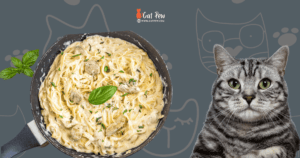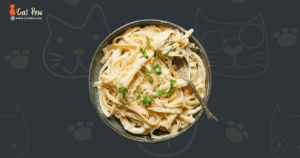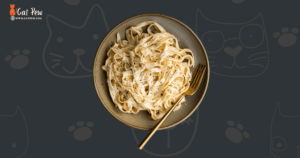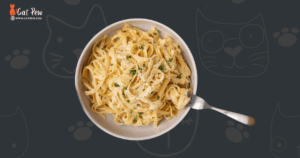Can Cats Eat Alfredo Sauce?
No, cats should not eat Alfredo sauce as it can be harmful to their health. Cats should not be fed Alfredo sauce because it can be harmful to their health.
While it may be tempting to share your delicious pasta dish with your furry friend, it is important to remember that cats have different dietary needs than humans. Alfredo sauce contains ingredients like garlic and onion, which are toxic to cats and can cause digestive upset, anemia, and even organ damage.
Additionally, the high fat and calorie content of Alfredo sauce can lead to obesity and other health issues in cats. It is best to stick to a balanced and appropriate diet for your feline companion, consisting of veterinarian-approved cat food.
Understanding The Ingredients In Alfredo Sauce

Alfredo sauce is not safe for cats to eat as it contains ingredients that can be harmful to them. Cats should stick to their own specially formulated food.
When it comes to the topic of what cats can or cannot eat, it’s essential to understand the individual ingredients in the food. One popular sauce that cat owners may wonder about is Alfredo sauce. This rich and creamy sauce, typically made from butter, cream, and Parmesan cheese, is commonly used in pasta dishes. However, it’s important to consider whether these ingredients are suitable for our feline friends.
Components Of Alfredo Sauce
Before we delve into the nutritional value of Alfredo sauce for cats, let’s take a closer look at its components:
| Ingredient | Description |
|---|---|
| Butter | Butter is a dairy product made from churning cream or milk. It is high in fat and can be problematic for cats, as they are obligate carnivores and do not require a significant amount of fat in their diet. |
| Cream | Cream, like butter, is also a dairy product. It is high in fat content and may lead to weight gain and digestive issues in cats. |
| Parmesan Cheese | Parmesan cheese is a hard cheese with a strong flavor. While a small amount may not be harmful, excessive consumption can lead to lactose intolerance symptoms, as many cats are lactose intolerant. |
Overview Of The Ingredients In Alfredo Sauce
Now that we have a better understanding of the individual ingredients in Alfredo sauce, let’s discuss their potential impact on a cat’s health:
- Butter: While a small amount of butter may not harm your cat, it is not a necessary or beneficial addition to their diet. The high-fat content can contribute to weight gain and potential digestive discomfort.
- Cream: Like butter, cream is high in fat and could lead to weight gain and digestive issues among cats. It is best to avoid feeding cats foods that contain significant amounts of cream.
- Parmesan Cheese: Parmesan cheese, although typically enjoyed by humans, can cause digestive problems in cats due to its lactose content. Cats lack the necessary enzymes to digest lactose and may experience diarrhea, vomiting, or other discomfort if consumed in excess.
Analyzing The Nutritional Value Of Alfredo Sauce
When it comes to the overall nutritional value of Alfredo sauce for cats, it falls short in terms of providing the necessary nutrients for their well-being. Although it contains some protein from the Parmesan cheese, it is outweighed by the high-fat content and potential lactose intolerance issues.
Cats require a diet that primarily consists of animal protein, essential fatty acids, and other essential nutrients. While sharing a tiny amount of Alfredo sauce as a treat or condiment occasionally may not be harmful, it is best to prioritize feeding them a balanced and nutritionally complete diet specific to their species.
The Risks Of Feeding Alfredo Sauce To Cats

Feeding your cat table scraps may seem like a harmless way to show them they’re loved, but it’s crucial to understand that not all human foods are safe for feline consumption. One such example is alfredo sauce, a creamy delight that may be tantalizing to our taste buds but poses risks to our feline friends. In this article, we’ll explore the potential health issues associated with feeding Alfredo sauce to cats and discuss the risks associated with dairy products for our furry companions.
Identifying Harmful Ingredients In Alfredo Sauce
Alfredo sauce typically contains a combination of butter, heavy cream, and Parmesan cheese. While these ingredients may be harmless or even beneficial for humans, they can have adverse effects on cats. Butter is high in fat, which can lead to obesity and gastrointestinal issues in cats. Additionally, the high lactose content in heavy cream and Parmesan cheese can be difficult for cats to digest, potentially causing digestive upset such as diarrhea or vomiting.
Exploring The Potential Health Issues In Cats
Feeding alfredo sauce to your cat can potentially lead to a range of health problems. Obesity is one concern, as the high-fat content in the sauce can contribute to weight gain in cats. This can put additional strain on their joints and lead to other obesity-related issues like diabetes and heart disease.
Moreover, the lactose contained in alfredo sauce can cause digestive upset in cats, particularly those who are lactose intolerant. Symptoms may include bloating, gas, diarrhea, and abdominal discomfort. Continuous exposure to lactose can result in long-term digestive issues for cats, impacting their overall well-being.
Risks Associated With Dairy Products For Cats
Dairy products, including cheese and cream, can sometimes be problematic for cats due to their lactose intolerance. Most cats lack the enzyme lactase, which is needed to break down lactose. This leads to difficulties in digesting dairy products and can cause gastrointestinal discomfort. It’s important to note that some cats may be more tolerant to small amounts of dairy, while others may have more severe reactions.
Feeding Alfredo sauce to your cat can be tempting, especially when they give you those adorable pleading eyes, but it’s vital to prioritize their health and well-being. Instead of sharing a plate of alfredo sauce, stick to a balanced feline diet packed with appropriate cat-friendly nutrients to ensure they receive all the essential vitamins and minerals they need for optimal health.
Alternatives To Alfredo Sauce For Cats

As much as we adore our feline friends, it’s important to remember that their dietary needs differ from ours. While a creamy plate of Alfredo sauce might be a tempting treat for us, it can pose certain risks to cats. Luckily, there are plenty of safe and delicious alternatives that can satisfy your cat’s cravings without compromising their health.
Safe Human Foods For Cats
Some human foods can be safely shared with our furry companions. When it comes to satisfying their taste buds, consider offering small amounts of the following cat-friendly options:
- Plain Cooked Chicken: A lean and protein-rich choice, plain-cooked chicken is a favorite among cats. Make sure to remove all bones and seasonings, as they may be harmful.
- Skinless Cooked Turkey: Another lean protein option, skinless cooked turkey can make a tasty and nutritious treat for your cat.
- Steamed Vegetables: Certain vegetables like carrots, peas, and green beans can be lightly steamed and offered as an occasional treat. However, avoid onions, garlic, and other potentially harmful vegetables.
- Plain Rice: Cooked plain rice can be a gentle addition to your cat’s diet, especially if they have an upset stomach. It should only be given in small amounts, as cats primarily require a meat-based diet.
Healthy Homemade Cat-friendly Sauces
If you’re looking to add some flavor to your cat’s meals, why not try making a homemade cat-friendly sauce? Not only can you control the ingredients, but you can also ensure it meets your cat’s dietary needs. Here are a few ideas to get you started:
- Tuna Puree: Blend a small amount of canned tuna in water or its juice to create a smooth puree. This sauce provides a burst of fishy goodness that many cats find irresistible.
- Chicken Broth: Diluted low-sodium chicken broth can add flavor to your cat’s food. Just make sure to use a broth without any added seasonings or onion, as those can be harmful.
- Pumpkin Puree: Not only is pumpkin a great source of fiber, but many cats also enjoy its taste. Mix plain canned pumpkin with some water to create a smooth sauce to drizzle over your cat’s food.
Store-bought Cat-friendly Sauces
If you’re not feeling particularly adventurous in the kitchen, there are also store-bought options available that are specifically formulated for cats. These sauces are specially designed to meet their nutritional needs and provide a tasty addition to their meals. When selecting a store-bought sauce, look for ones made from high-quality ingredients, without any artificial additives or preservatives. Your cat will thank you for the flavorful variety!
Introducing New Foods To Your Cat’s Diet

As a cat owner, you might find yourself wondering whether it’s safe or even beneficial to share certain human foods with your feline friend. One such food is Alfredo sauce. While some human foods can be introduced into a cat’s diet in moderation, it’s crucial to do so in a controlled manner to avoid any potential negative reactions. In this section, we will discuss the importance of gradual food introductions, provide tips for transitioning your cat to new foods, and emphasize the significance of monitoring your cat’s reaction.
The Importance Of Gradual Food Introductions
When it comes to introducing new foods to your cat, it’s important to take a gradual approach. Cats have specific dietary needs, and sudden changes to their diet can upset their digestive system. By introducing new foods gradually, you allow your cat’s body to adjust and minimize the chances of any adverse reactions or gastrointestinal disturbances.
To gradually introduce new foods to your cat’s diet, follow these steps:
- Start by mixing a small amount of the new food with your cat’s regular food. Ensure the pieces of food are small and easy to consume.
- For several days, gradually increase the proportion of the new food while decreasing the proportion of the regular food. This gradual transition gives your cat’s taste buds and digestive system time to adapt.
- Observe your cat’s response to the new food during this transition period. Look for any signs of digestive upset or allergic reactions such as vomiting, diarrhea, or excessive scratching.
By introducing new foods to your cat’s diet gradually, you’re providing them with an opportunity to adjust and ensure their overall health and well-being.
Tips For Transitioning Cats To New Foods
Transitioning your cat to a new food can require some patience and strategy. Here are some tips to make the process smoother:
- Stick to high-quality, balanced cat foods that align with your cat’s nutritional needs.
- Consider mixing in a small amount of the new food with your cat’s favorite treats to make it more appealing.
- Ensure your cat has access to fresh water at all times, as increasing the intake of new foods may cause them to feel thirstier.
- If your cat is hesitant to try the new food, try warming it up slightly or adding a small amount of low-sodium broth to enhance the aroma and flavor.
Remember, patience is key during this transition period. Cats can be creatures of habit, and it may take some time for them to fully accept the new food. Stay consistent and gradually increase the proportion of the new food until it becomes the primary component of their diet.
Monitoring Your Cat’s Reaction To New Foods
During the transition period and after your cat has fully incorporated the new food into their diet, it’s crucial to monitor their reaction and behavior. Keep an eye out for any signs of discomfort or adverse effects. If you notice any digestive issues, allergic reactions, or a significant change in your cat’s behavior, consult your veterinarian for guidance.
Remember, each cat is unique, and what works for one may not work for another. Ensuring that your cat tolerates and enjoys the new food is essential in maintaining their overall health and happiness.

Frequently Asked Questions On Can Cats Eat Alfredo Sauce
What Sauces Can Cats Eat?
Cats can safely eat certain sauces like plain tomato sauce, meat drippings, or fish broth. However, it’s important to avoid sauces with toxic ingredients like garlic, onion, or too much salt. Always consult your veterinarian before introducing any new food to your cat’s diet.
Can Cats Eat Pasta Sauce?
Cats should not eat pasta sauce as it may contain ingredients that are harmful to them.
Can Cats Have Fettuccine?
Cats should not have fettuccine as it can be harmful to their health. Fettuccine is a type of pasta and cats are carnivores, so their diet should primarily consist of meat. Feeding them fettuccine can lead to digestive issues and nutrient imbalances.
Stick to cat-friendly foods for their well-being.
Can Cats Eat Pasta?
Yes, cats can eat pasta. However, it should only be given in moderation and cooked without any seasoning or sauce. It’s important to remember that cats have specific dietary needs, so consult your veterinarian before introducing pasta into their diet.
Conclusion
While Alfredo sauce may be a tasty treat for humans, it is not recommended for cats. Cats have specific dietary needs and digesting ingredients like garlic, onion, and excessive dairy can be harmful to their health. It’s always best to stick to a balanced, species-appropriate diet for our feline friends to ensure their well-being.

Winston
I'm Winston, the author of this feline-focused (Catpew.com) blog . My love for cats goes back to my childhood, when I spent countless hours playing with my family's tabby, Mittens. This furry friend instilled in me a deep appreciation for the unique personalities, playful nature, and unconditional love that cats offer.

